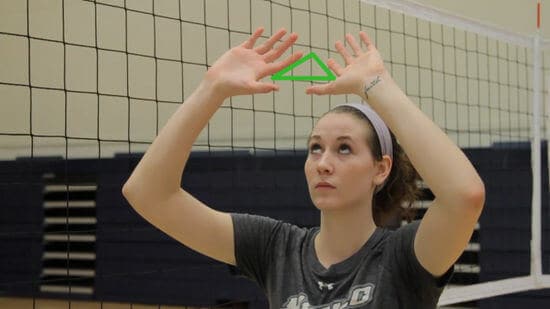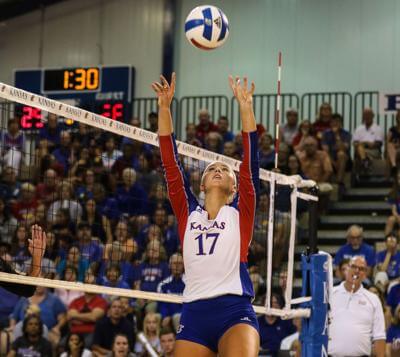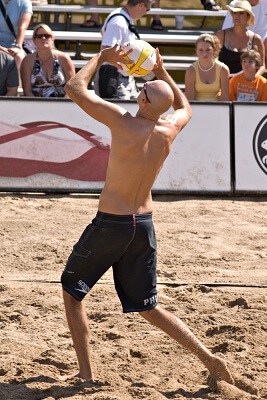Table of Contents
Hand Setting in Volleyball
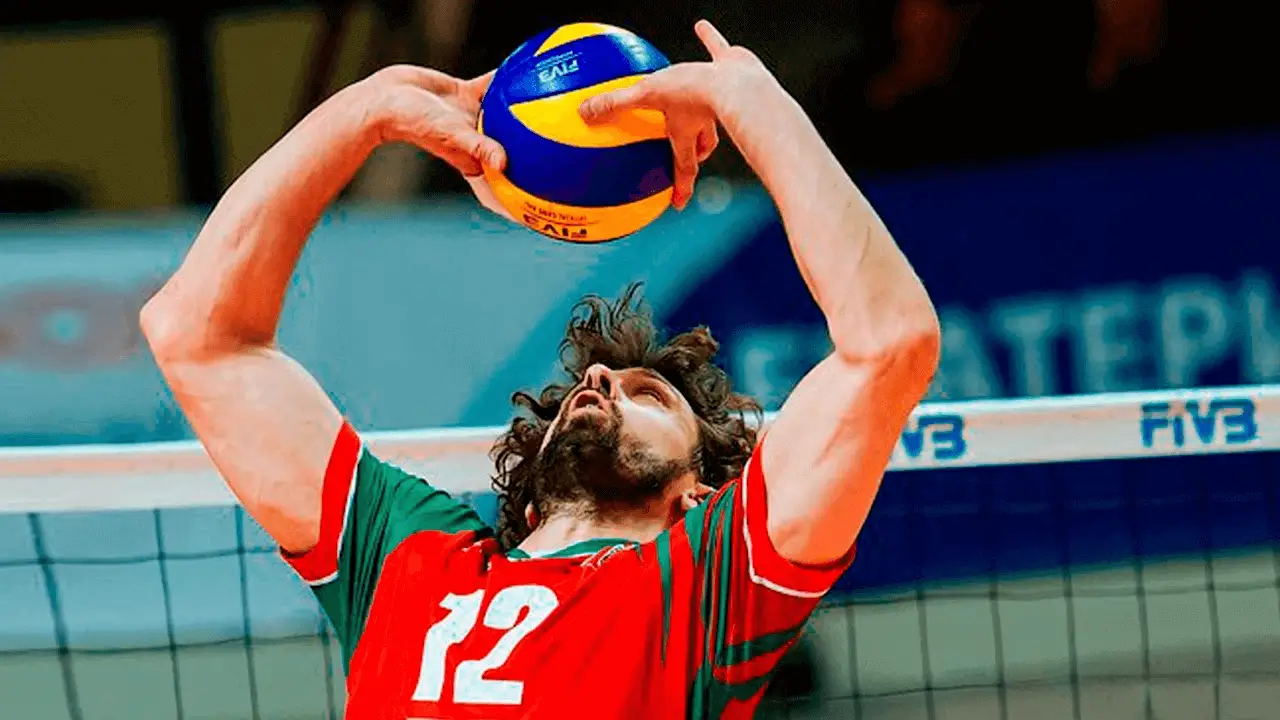
Hand setting is one of the most technically difficult skills in volleyball that plays a major role in the sport in nearly every single match, point and rally. Again depending on whether you are playing beach volleyball or indoor volleyball will dictate what is a legal handset and what is an illegal handset however the technique is very similar for both. With that being said I will go over the basics of how to perform a handset and what is considered good form. Once I have covered the basics I will tangent off into the differences between the beach volleyball hand set and indoor handset.
How to Perform a Hand Set in Volleyball
Let us first focus on the positioning of your hands. Your hands should be above your head with your arms slightly bent. Your hands should be directly above your forehead, you know your hands are in the right place if you could miss the ball with your hands completely and head the ball using your forehead (like a soccer player).

With your hands you want to form a separated triangle pattern with your thumbs and forefingers with your remaining fingers slightly spread, the aim of this form is to create a bowl/ dish like shape to cradle the ball before pushing it back away to the setting target.
Once the ball contacts your hands you want gently wrap your hands around the bottom and sides of the ball before extending your arms fully and pushing towards the target, as the ball leaves your hands you want to open them out like french doors. The reason for this is if you open your hands like french doors and the ball does not spin, it means the ball has left both hands at the same time and therefore you haven’t double touched the ball.
It is important to ensure your hands remain relaxed and smooth throughout the setting motion.
The next thing to consider when hand setting is you don’t want your elbows to flair out, you want them keep in and inline with your shoulders as best you can.
Now you have a better understanding of what your hands and arms are to do let’s move on to the lower body, firstly you want to keep your core tight and not let your body lean back when performing your set. You want to keep you body weight centred and underneath the ball, the further you want to set the ball you will adjust your body accordingly, so if you want to set the ball further you want to put your bodyweight more behind the ball whereas if you wish to set the ball higher and closer to you, you want to put your bodyweight more underneath the ball.
The next thing to consider if your feet placement and legs. You want to have slightly bent knees so that when you are performing your set you can use the extension of your legs and momentum of your body weight to propel the ball as opposed to throwing the ball with your arms, this will give you a lot more control with your set. With feet placement you generally want to have a staggered stance with your feet approximately shoulder width apart.
Hand setting in Beach Volleyball
Setting in beach volleyball is generally tougher than setting indoors the reason for this is as follows; the rules are a lot stricter and you aren’t just competing with the refs you are also fighting the elements such as wind, run and sun.
In beach volleyball the most common call given is the double contact. As I stated before, in volleyball a player can’t touch the ball more than once consecutively, if when setting, the ball has a lot of spin on it this generally means the ball has left one hand at a different time to the other meaning each hand has touched the ball and therefore a two touch call would be given. It is worth noting that the ball spinning isn’t necessarily mean it’s a double but it can be an indicator.
Touching back on setting in the wind it is important to gauge the wind direction and strength as quickly as possible, the reason for this is depending on the direction of the wind it may alter your setting location drastically.

For example if the wind is blowing directly into your face you may have to aim more inwards to the court to allow the wind to naturally drift the ball out to the hitter. Alternatively if the wind is blowing from behind you would need to set the ball aiming quite far out of the court past the aerials to allow the wind to blow the ball towards the net and into the hitters batter box (Learn more about the batters box here).
I want to squash some common myths that often raise their heads when playing beach volleyball.
Firstly let’s talk about setting outside your shoulder line, this is completely 100% legal providing you are setting your teammate to hit the ball and not setting directly over the net. This takes me on to my next point setting directly over the net again this is 100% legal however there is some stipulation with this one, you can only set over the net if you set directly inline with your shoulders this includes both setting forwards and setting reverse.
As you can see the rules are quite vague in the sense of it is very difficult to determine if a ball has left the hands at a different time and it;s even harder to tell if the ball has been set over on the 2nd touch perfectly in line with the shoulder.
Hand Setting in Indoor Volleyball
As I said before you generally will get away with a lot more indoor then you will on beach. When playing indoor volleyball the same rules apply regarding the lift, carry, double touch etc.. however the difference with Indoor is generally referee’s don’t like to see you holding onto the ball for too long so I feel that the carry/ lift call is the more common fault when setting indoor. The carry or lift is called when the referee has determined the ball has laid to a complete rest in your hands or they notice your hands physically moving downwards with the ball prior to setting the ball.
In indoor volleyball it is a lot more common jump set, the technique as detailed above is still applicable to jump setting however you want to try and utilise the moment from your jump to get the ball to its desired location as opposed to throwing the ball with just your arms. Setting for indoor volleyball is a difficult thing to do as every single player has a completely different set and more importantly every player you are setting requires a different set. My advice when setting indoors is to use the aforementioned technique and lots of practice until you find your own style that feels comfortable.
What I want to cover more in this section is the different types of you will most commonly use. Now if you are completely new to volleyball and you have read my ‘what is volleyball article’ you will now know the main positions in indoor are as follows: outside hitter, middle hitter and opposite, I am going to tell you where you would commonly be setting from and where you set each of these players.
So when setting indoor most teams set from position 2.5 (this is in between position 2 (opposite player) and 3 (Middle Hitter) please refer to the below picture for clarity.
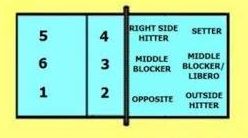
When setting your outside player or as the picture above shows the 4 player you are normally setting across the court aiming to give your outside hitter time to see the set and approach to hit the ball. Normally you are setting out towards the aerials that are strapped to the net. Now as you get more advanced there is many different hitting options for a 4 player, they may want to a chute set which is a quick set that stays almost parallel to the net or they may want to hit inside a little bit more so they may ask for a ball just over the top of the middle hitter. However like I said these are move advanced moves which I will cover in another article
Outside hitter in action
The next position is the middle hitter now again how you set them may depend on what level you and your teammates are however traditionally speaking a middle hitter wants to hit what is known as a short. A short set is when you set the ball very quick, low and very close to yourself to allow the middle hitter to contact the ball before the blockers have a chance to react. This is a difficult set to master as normally the middle hitter will jump the second the ball touches your hands so you aim is to locate the middle hitter and place that ball directly in their path. See below for some fantastic examples
The last position that is vital to know is the opposite player also known as the 2 hitter (again refer to the picture above showing numbers). It is quite common that to set the 2 player you would carry out a reverse set however I would still suggest if you are new to volleyball set the way you are facing and work on getting your body round the ball to set the opposite player. Now you want to aim in a similar position to where you are trying to set the outside hitter however it is important to note whether your opposite is right or left handed. If the hitter is right handed you want to aim towards the aerial which means you want to set the ball slightly further as the right handed player must let the ball come across their body first. However if they are left handed it will be a much closer set as they don’t have to wait and can attack the ball instantly.
Honorable mentions
I don’t want to confuse things too much but there are more places you can still set. You still have all these back court players that you can use to hit the ball either to mix things up and throw the blocking team off or alternatively they can be a big help if your passers are struggling to get the ball to that 2.5 position. The first set I will touch on is known as a 10 set, a 10 set is when you put the ball out towards the 2 position however you will aim slightly more towards your own 3m line with the set, this way your player at the 1 position can jump from the back court and attack the ball. This set is often used when you as the setter are front court and your opposite player is back court.
The next commonly used set is known as the pipe attack, this is where you set the ball just over the top of the middle again towards the 3m line to allow your back court player in position 6 to jump and attack the ball, this set is often used when you have a strong outside hitter in the back row or if the pass isn’t good enough for you to set the ball anywhere else.
So now we have all the others players out the way, let’s talk about how we as setters can have a little more fun. In indoor volleyball you are allowed to set the ball one handed as long as it is not a lift or carry, it is a difficult skill to master and I wouldn’t recommend you use it unless absolutely necessary but it is definitely a tool to have in your arsenal as it not only gets you out of sticky situations but my god does it look good to. See below for my favourite one hand set ever.
The next thing you can do as a setter is to pretend to go and set the ball but play over on the 2nd touch. This can be executed in a few different ways, if the pass is good and you want to disguise it you can set over your shoulder straight over the net and trick the blockers before they are ready. The next way in which it can be executed is by attacking with a spike if the ball is passed to tight to the net or you spot the blockers not ready. The last way in which you can execute this is what is known as dumping, this is generally done on a good pass that is above the height of the net. The way in which it is executed is as you jump up to set the ball, when the ball enters your hands above the net you set the ball directly down with force into the opponent’s side.
Well that about sums up setting indoors and the basics involved.
Number 1 tip to improve your setting right now!!
The thing with setting is once you have the basics and the technique right it is largely a mental battle with yourself. The number one thing that will improve your setting right now is being confident, everytime you set the ball think and believe it is going to come out perfectly, the more you believe it the more likely it is to come true.

